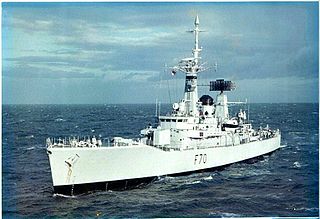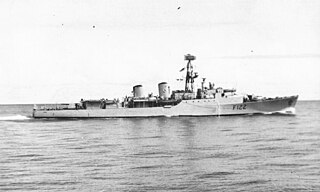
The Type 22 frigate also known as the Broadsword class was a class of frigates built for the British Royal Navy. Fourteen were built in total, with production divided into three batches.

The County class was a class of British guided missile destroyers, the first such warships built by the Royal Navy. Designed specifically around the Seaslug anti-aircraft missile system, the primary role of these ships was area air defence around the aircraft carrier task force in the nuclear-war environment.

The Type 21 frigate, or Amazon-class frigate, was a British Royal Navy general-purpose escort that was designed in the late 1960s, built in the 1970s and served throughout the 1980s into the 1990s.

HMS Hampshire was a County-class destroyer of the Royal Navy. Laid down, in March 1959 a couple of weeks behind the class leader Devonshire, she was classified as a guided missile destroyer, as the Sea Lords regarded the concept of the cruiser and big gun ship as discredited by the perceived failure of the Tiger class and the obsolescence of the heavy gun. The description of guided missile destroyer seemed more likely to win approval from the Treasury and Government for an adequate number of warships the size of small cruisers, which could play many traditional cruiser flagship and command functions, but had no armour around its gun and missile magazine.

HMS Kent was a batch-1 County-class destroyer of the Royal Navy. She and her sisters were equipped with the Sea Slug Mk-1 medium-range surface-to-air missile SAM system, along with the short-range Sea Cat SAM, two twin 4.5-inch gun turrets, two single 20mm cannon, ASW torpedo tubes, and a platform and hangar that allowed her to operate one Wessex helicopter. The County class were large ships, with good seakeeping abilities and long range, and were ideal blue-water ships for their time.

The Type 14 Blackwood class were a ship class of minimal "second-rate" anti-submarine warfare frigates. Built for the Royal Navy during the 1950s at a time of increasing threat from the Soviet Union's submarine fleet, they served until the late 1970s. Twelve ships of this class served with the Royal Navy and a further three were built for the Indian Navy.

The Leander-class, or Type 12I (Improved) frigates, comprising twenty-six vessels, was among the most numerous and long-lived classes of frigate in the Royal Navy's modern history. The class was built in three batches between 1959 and 1973. It had an unusually high public profile, due to the popular BBC television drama series Warship. The Leander silhouette became synonymous with the Royal Navy through the 1960s until the 1980s.

The Type 12 or Whitby-class frigates were a six-ship class of anti-submarine frigates of the Royal Navy, which entered service late in the 1950s. They were designed in the early 1950s as first-rate ocean-going convoy escorts, in the light of experience gained during World War II. At this time, the Royal Navy were designing single-role escorts and the Whitbys were designed as fast convoy escorts capable of tackling high-speed submarines. However, this made the Whitbys more expensive and sophisticated to produce in large numbers in the event of a major war, and so the Type 14 "utility" or "second-rate" anti-submarine frigate was developed to complement the Type 12. Although themselves rapidly outdated, the Type 12 proved to be an excellent basis for a series of frigate designs used by the British and Commonwealth navies for the next 20 years.

The Daring class was a class of eleven destroyers built for the Royal Navy (RN) and Royal Australian Navy (RAN). Constructed after World War II, and entering service during the 1950s, eight ships were constructed for the RN, and three ships for the RAN. Two of the RN destroyers were subsequently sold to and served in the Peruvian Navy (MGP). A further eight ships were planned for the RN but were cancelled before construction commenced, while a fourth RAN vessel was begun but was cancelled before launch and broken up on the slipway.

HMS Danae was a Leander-class frigate of the Royal Navy. She was, like the rest of the class, named after a figure of mythology. Danae was built by Devonport Dockyard. She was launched on 31 October 1965 and commissioned on 10 October 1967.

HMS Gurkha (F122) was a Tribal-class frigate of the Royal Navy. She was named after an ethnic group located in Nepal, and who continue to serve in the British Army. She was sold to the Indonesian Navy in 1984 and renamed KRI Wilhelmus Zakarias Yohannes (332).

HMS Mohawk was a Tribal-class frigate of the Royal Navy in service from 1963. She was named after a tribe of Native Americans located in southeast Canada and New York State. Mohawk was scrapped in 1983.

HMS Zulu (F124) was a Tribal-class frigate of the Royal Navy in service from 1964 to 1984. She was the third ship bearing the name of HMS Zulu, having been named after an ethnic group located primarily in KwaZulu-Natal Province, South Africa. Zulu was built by Alexander Stephen and Sons, of Govan. She was launched on 3 July 1962 and commissioned on 17 April 1964.

The Type 82 or Bristol-class destroyer was a 1960s guided missile destroyer design intended to replace County-class destroyers in the Royal Navy. Originally eight warships were planned to provide area air-defence for the four planned CVA-01 aircraft carriers. They would also have been able to operate independently as modern cruisers "East of Suez".

The Type 41 or Leopard class were a class of anti-aircraft defence frigates built for the Royal Navy and Indian Navy in the 1950s. The Type 41, together with the Type 61 variant introduced diesel propulsion into the Royal Navy, the perceived benefits being long range, low fuel use, reduced crew, and reduced complexity.

The Type 61 Salisbury class was a class of the Royal Navy aircraft direction (AD) frigate, built in the 1950s. The purpose of the aircraft direction ships was to provide radar picket duties at some distance from a carrier task force and offer interception guidance to aircraft operating in their area.

The Rothesay class, or Type 12M frigates were a class of frigates serving with the Royal Navy, South African Navy and the Royal New Zealand Navy.
The Type system is a classification system used by the British Royal Navy to classify surface escorts by function. The system evolved in the early 1950s, when the Royal Navy was experimenting with building single-purpose escort vessels with specific roles in light of experience gained in World War II. The original numbering scheme was:

HMNZS Taranaki (F148) was a modified Rothesay-class frigate in service with the Royal New Zealand Navy (RNZN) from 1960 to 1982. Along with her sister ship Otago, the pair of ships formed a core part of the RNZN escort force throughout the 1960s and 1970s. She was named after Taranaki Province.

HMNZS Waikato (F55) was a Leander Batch 2TA frigate of the Royal New Zealand Navy (RNZN). She was one of two Leanders built for the RNZN, the other being the Batch 3 HMNZS Canterbury. These two New Zealand ships relieved British ships of the Armilla patrol during the Falklands conflict, freeing British ships for deployment.



















